Hospitality Management Homework: Communication, Service & Scenarios
VerifiedAdded on 2022/09/09
|10
|2187
|15
Homework Assignment
AI Summary
This hospitality management assignment delves into various aspects of the industry, starting with an exploration of assertive, passive, and aggressive communication styles across different scenarios. It then analyzes win-win versus win-lose solutions, emphasizing the importance of the former in fostering positive relationships. The assignment continues by identifying the knowledge, skills, and behaviors essential for success, particularly in a front office setting, and highlights the critical role of good customer service. It provides steps to improve service orientation and offers practical advice for handling challenging customer situations. The assignment concludes by examining the five stages of the communication process, identifying potential communication problems in large hospitality businesses, and suggesting solutions to enhance communication effectiveness.
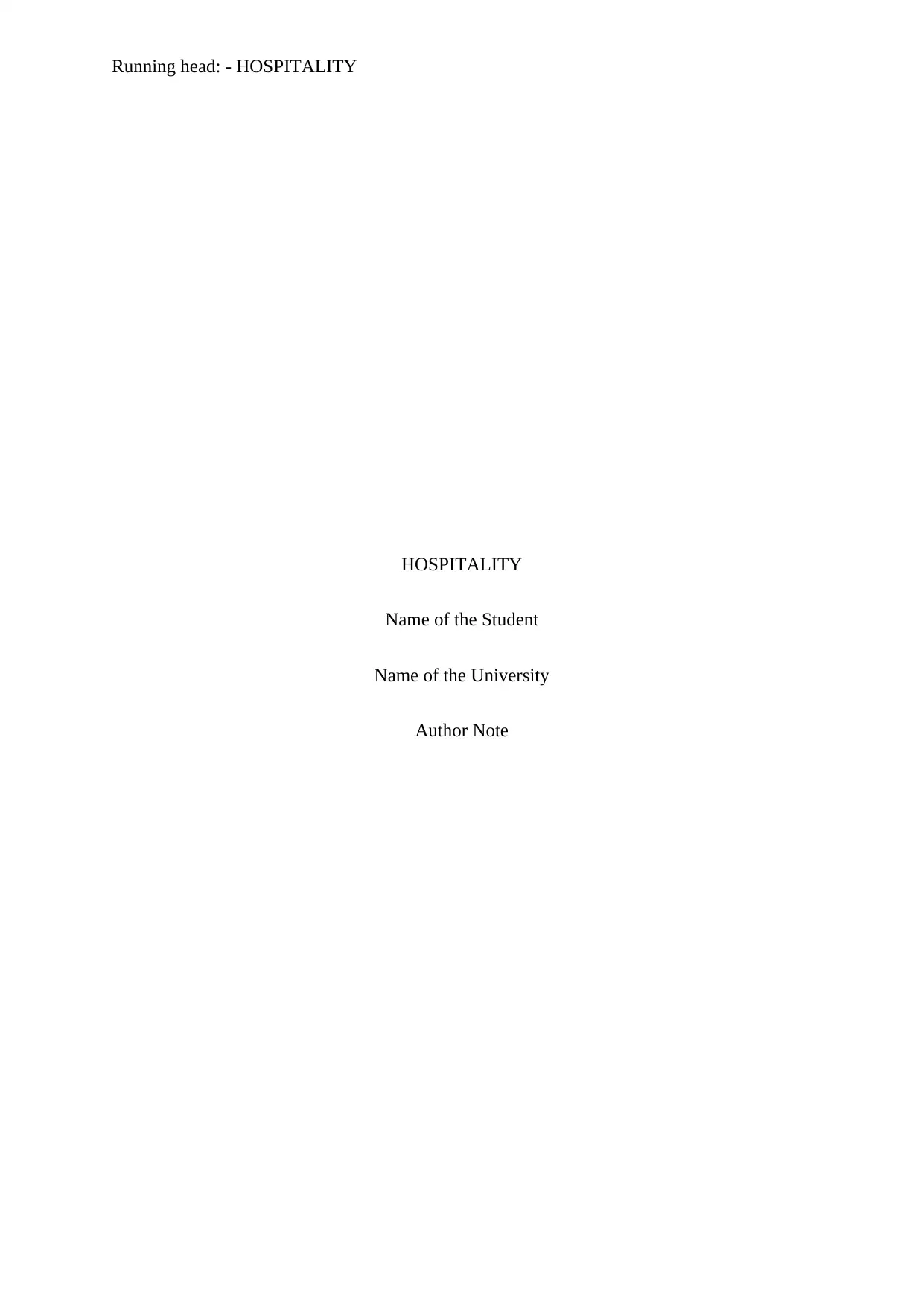
Running head: - HOSPITALITY
HOSPITALITY
Name of the Student
Name of the University
Author Note
HOSPITALITY
Name of the Student
Name of the University
Author Note
Paraphrase This Document
Need a fresh take? Get an instant paraphrase of this document with our AI Paraphraser
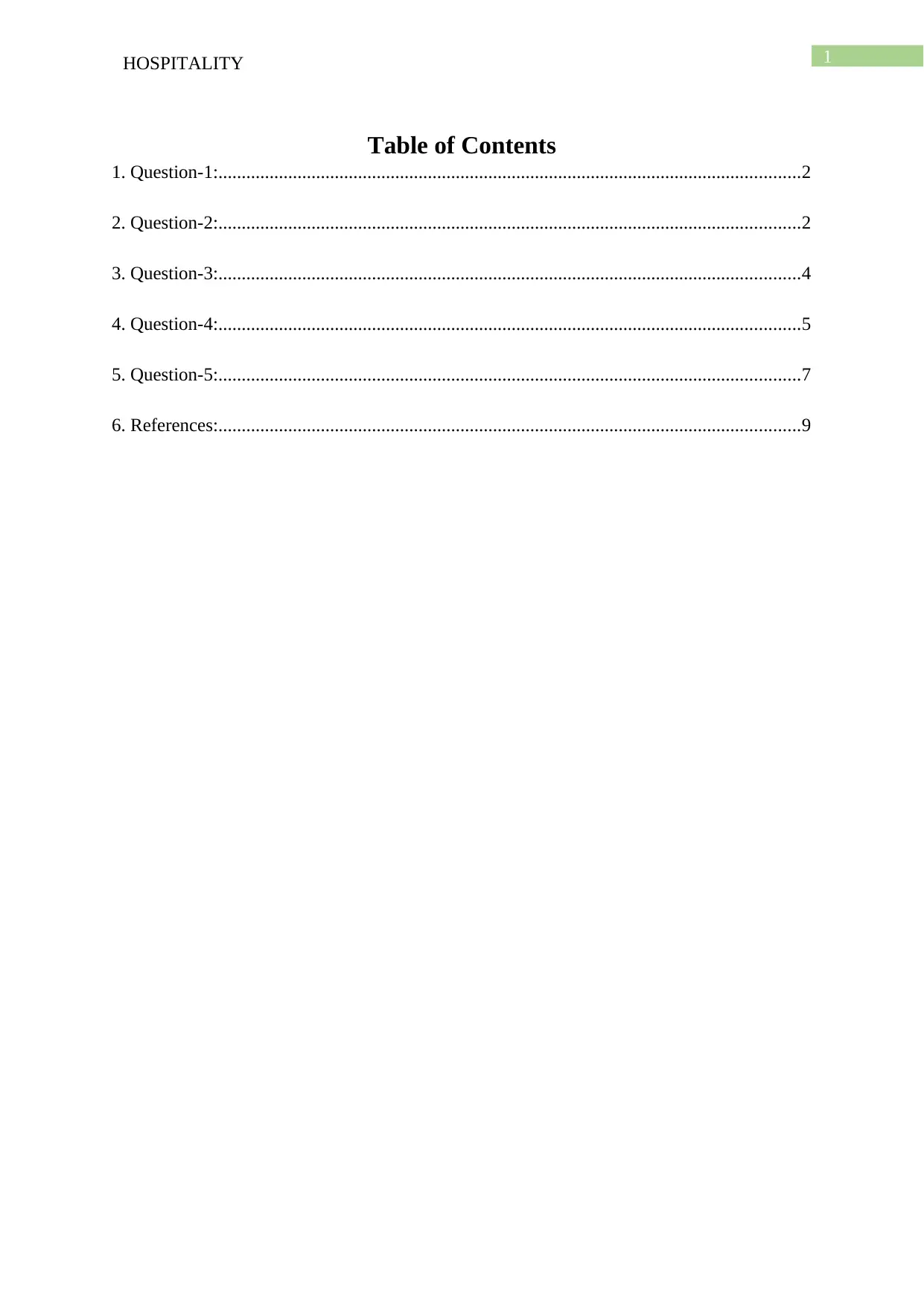
1HOSPITALITY
Table of Contents
1. Question-1:.............................................................................................................................2
2. Question-2:.............................................................................................................................2
3. Question-3:.............................................................................................................................4
4. Question-4:.............................................................................................................................5
5. Question-5:.............................................................................................................................7
6. References:.............................................................................................................................9
Table of Contents
1. Question-1:.............................................................................................................................2
2. Question-2:.............................................................................................................................2
3. Question-3:.............................................................................................................................4
4. Question-4:.............................................................................................................................5
5. Question-5:.............................................................................................................................7
6. References:.............................................................................................................................9
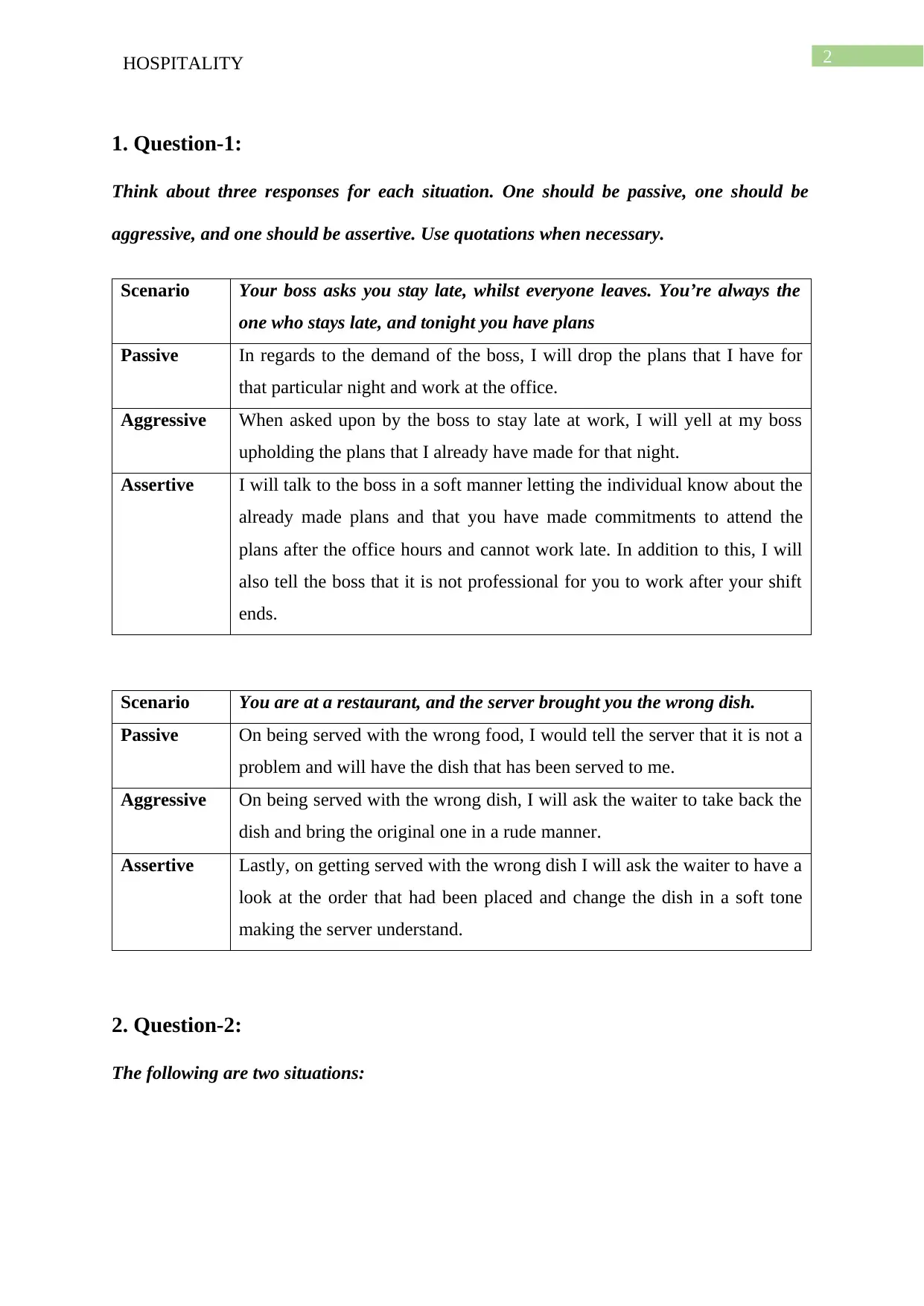
2HOSPITALITY
1. Question-1:
Think about three responses for each situation. One should be passive, one should be
aggressive, and one should be assertive. Use quotations when necessary.
Scenario Your boss asks you stay late, whilst everyone leaves. You’re always the
one who stays late, and tonight you have plans
Passive In regards to the demand of the boss, I will drop the plans that I have for
that particular night and work at the office.
Aggressive When asked upon by the boss to stay late at work, I will yell at my boss
upholding the plans that I already have made for that night.
Assertive I will talk to the boss in a soft manner letting the individual know about the
already made plans and that you have made commitments to attend the
plans after the office hours and cannot work late. In addition to this, I will
also tell the boss that it is not professional for you to work after your shift
ends.
Scenario You are at a restaurant, and the server brought you the wrong dish.
Passive On being served with the wrong food, I would tell the server that it is not a
problem and will have the dish that has been served to me.
Aggressive On being served with the wrong dish, I will ask the waiter to take back the
dish and bring the original one in a rude manner.
Assertive Lastly, on getting served with the wrong dish I will ask the waiter to have a
look at the order that had been placed and change the dish in a soft tone
making the server understand.
2. Question-2:
The following are two situations:
1. Question-1:
Think about three responses for each situation. One should be passive, one should be
aggressive, and one should be assertive. Use quotations when necessary.
Scenario Your boss asks you stay late, whilst everyone leaves. You’re always the
one who stays late, and tonight you have plans
Passive In regards to the demand of the boss, I will drop the plans that I have for
that particular night and work at the office.
Aggressive When asked upon by the boss to stay late at work, I will yell at my boss
upholding the plans that I already have made for that night.
Assertive I will talk to the boss in a soft manner letting the individual know about the
already made plans and that you have made commitments to attend the
plans after the office hours and cannot work late. In addition to this, I will
also tell the boss that it is not professional for you to work after your shift
ends.
Scenario You are at a restaurant, and the server brought you the wrong dish.
Passive On being served with the wrong food, I would tell the server that it is not a
problem and will have the dish that has been served to me.
Aggressive On being served with the wrong dish, I will ask the waiter to take back the
dish and bring the original one in a rude manner.
Assertive Lastly, on getting served with the wrong dish I will ask the waiter to have a
look at the order that had been placed and change the dish in a soft tone
making the server understand.
2. Question-2:
The following are two situations:
⊘ This is a preview!⊘
Do you want full access?
Subscribe today to unlock all pages.

Trusted by 1+ million students worldwide
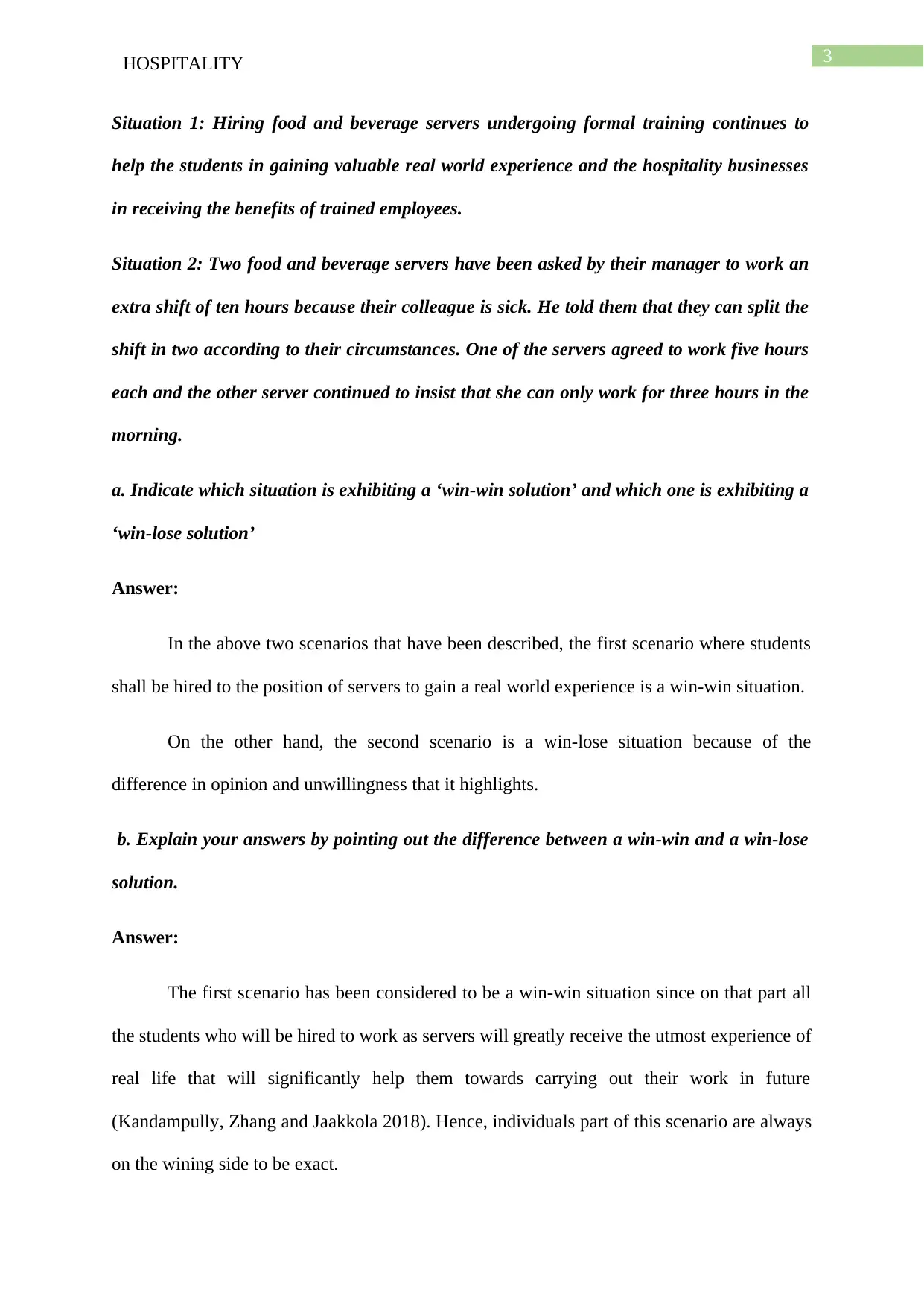
3HOSPITALITY
Situation 1: Hiring food and beverage servers undergoing formal training continues to
help the students in gaining valuable real world experience and the hospitality businesses
in receiving the benefits of trained employees.
Situation 2: Two food and beverage servers have been asked by their manager to work an
extra shift of ten hours because their colleague is sick. He told them that they can split the
shift in two according to their circumstances. One of the servers agreed to work five hours
each and the other server continued to insist that she can only work for three hours in the
morning.
a. Indicate which situation is exhibiting a ‘win-win solution’ and which one is exhibiting a
‘win-lose solution’
Answer:
In the above two scenarios that have been described, the first scenario where students
shall be hired to the position of servers to gain a real world experience is a win-win situation.
On the other hand, the second scenario is a win-lose situation because of the
difference in opinion and unwillingness that it highlights.
b. Explain your answers by pointing out the difference between a win-win and a win-lose
solution.
Answer:
The first scenario has been considered to be a win-win situation since on that part all
the students who will be hired to work as servers will greatly receive the utmost experience of
real life that will significantly help them towards carrying out their work in future
(Kandampully, Zhang and Jaakkola 2018). Hence, individuals part of this scenario are always
on the wining side to be exact.
Situation 1: Hiring food and beverage servers undergoing formal training continues to
help the students in gaining valuable real world experience and the hospitality businesses
in receiving the benefits of trained employees.
Situation 2: Two food and beverage servers have been asked by their manager to work an
extra shift of ten hours because their colleague is sick. He told them that they can split the
shift in two according to their circumstances. One of the servers agreed to work five hours
each and the other server continued to insist that she can only work for three hours in the
morning.
a. Indicate which situation is exhibiting a ‘win-win solution’ and which one is exhibiting a
‘win-lose solution’
Answer:
In the above two scenarios that have been described, the first scenario where students
shall be hired to the position of servers to gain a real world experience is a win-win situation.
On the other hand, the second scenario is a win-lose situation because of the
difference in opinion and unwillingness that it highlights.
b. Explain your answers by pointing out the difference between a win-win and a win-lose
solution.
Answer:
The first scenario has been considered to be a win-win situation since on that part all
the students who will be hired to work as servers will greatly receive the utmost experience of
real life that will significantly help them towards carrying out their work in future
(Kandampully, Zhang and Jaakkola 2018). Hence, individuals part of this scenario are always
on the wining side to be exact.
Paraphrase This Document
Need a fresh take? Get an instant paraphrase of this document with our AI Paraphraser
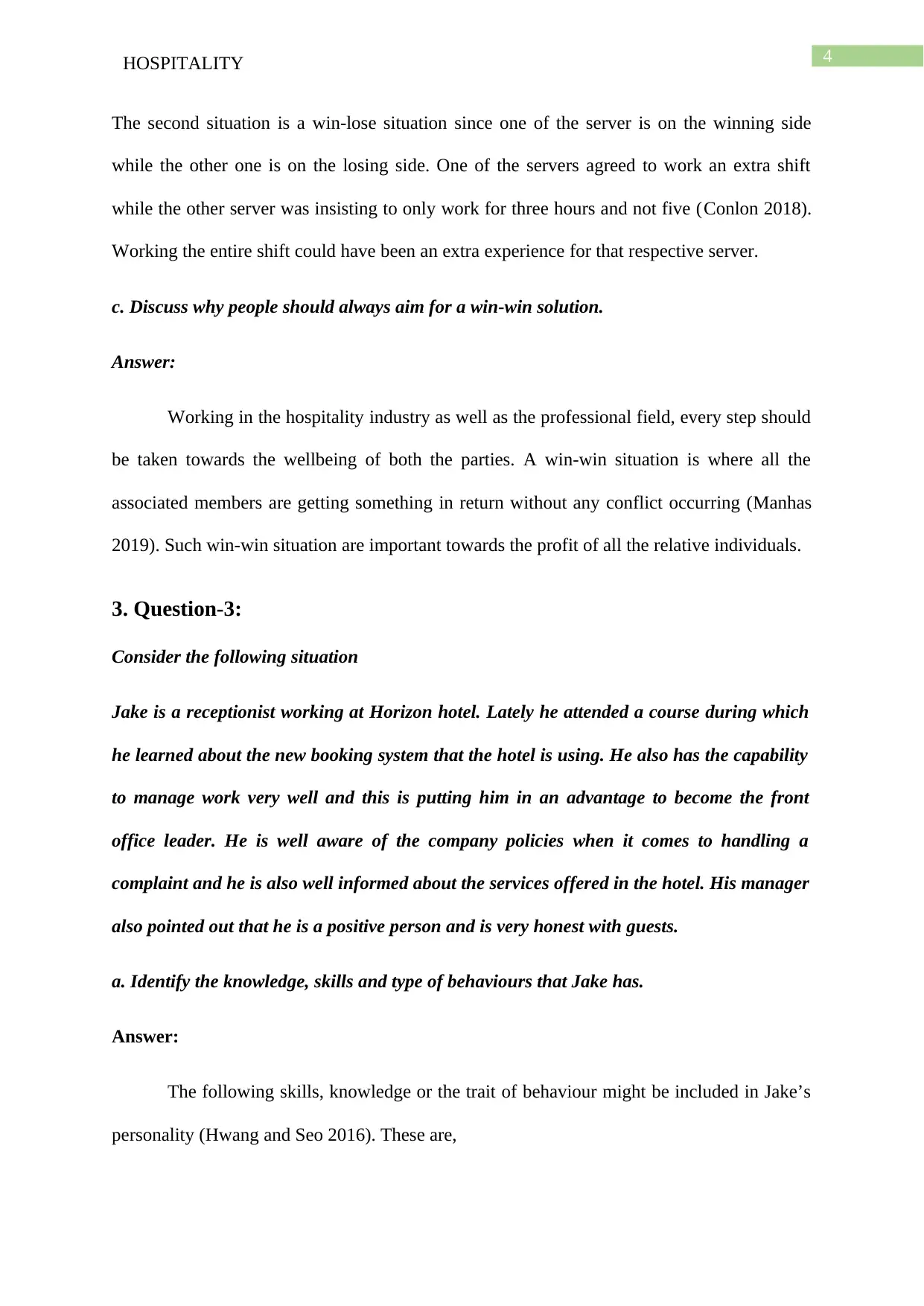
4HOSPITALITY
The second situation is a win-lose situation since one of the server is on the winning side
while the other one is on the losing side. One of the servers agreed to work an extra shift
while the other server was insisting to only work for three hours and not five (Conlon 2018).
Working the entire shift could have been an extra experience for that respective server.
c. Discuss why people should always aim for a win-win solution.
Answer:
Working in the hospitality industry as well as the professional field, every step should
be taken towards the wellbeing of both the parties. A win-win situation is where all the
associated members are getting something in return without any conflict occurring (Manhas
2019). Such win-win situation are important towards the profit of all the relative individuals.
3. Question-3:
Consider the following situation
Jake is a receptionist working at Horizon hotel. Lately he attended a course during which
he learned about the new booking system that the hotel is using. He also has the capability
to manage work very well and this is putting him in an advantage to become the front
office leader. He is well aware of the company policies when it comes to handling a
complaint and he is also well informed about the services offered in the hotel. His manager
also pointed out that he is a positive person and is very honest with guests.
a. Identify the knowledge, skills and type of behaviours that Jake has.
Answer:
The following skills, knowledge or the trait of behaviour might be included in Jake’s
personality (Hwang and Seo 2016). These are,
The second situation is a win-lose situation since one of the server is on the winning side
while the other one is on the losing side. One of the servers agreed to work an extra shift
while the other server was insisting to only work for three hours and not five (Conlon 2018).
Working the entire shift could have been an extra experience for that respective server.
c. Discuss why people should always aim for a win-win solution.
Answer:
Working in the hospitality industry as well as the professional field, every step should
be taken towards the wellbeing of both the parties. A win-win situation is where all the
associated members are getting something in return without any conflict occurring (Manhas
2019). Such win-win situation are important towards the profit of all the relative individuals.
3. Question-3:
Consider the following situation
Jake is a receptionist working at Horizon hotel. Lately he attended a course during which
he learned about the new booking system that the hotel is using. He also has the capability
to manage work very well and this is putting him in an advantage to become the front
office leader. He is well aware of the company policies when it comes to handling a
complaint and he is also well informed about the services offered in the hotel. His manager
also pointed out that he is a positive person and is very honest with guests.
a. Identify the knowledge, skills and type of behaviours that Jake has.
Answer:
The following skills, knowledge or the trait of behaviour might be included in Jake’s
personality (Hwang and Seo 2016). These are,
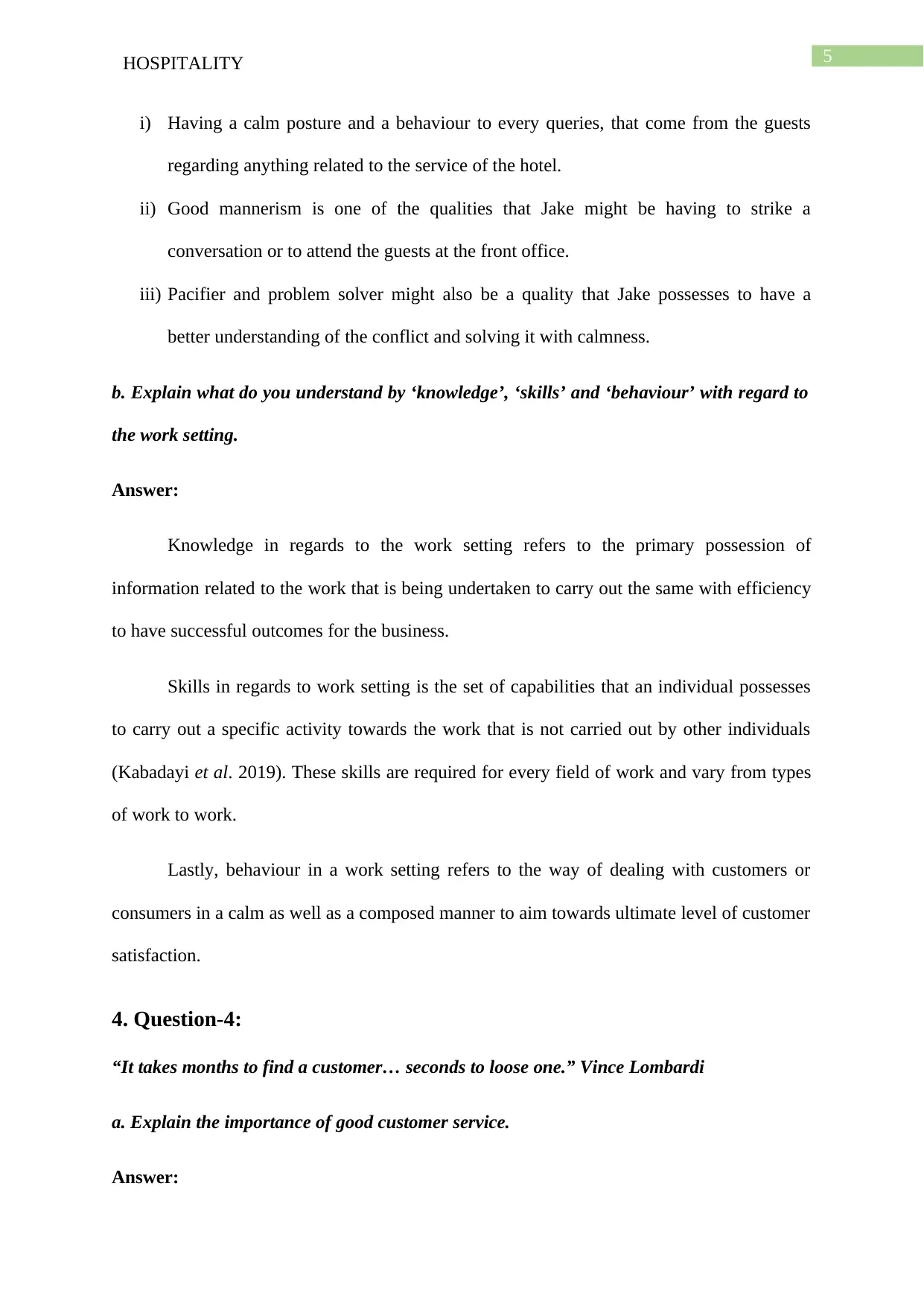
5HOSPITALITY
i) Having a calm posture and a behaviour to every queries, that come from the guests
regarding anything related to the service of the hotel.
ii) Good mannerism is one of the qualities that Jake might be having to strike a
conversation or to attend the guests at the front office.
iii) Pacifier and problem solver might also be a quality that Jake possesses to have a
better understanding of the conflict and solving it with calmness.
b. Explain what do you understand by ‘knowledge’, ‘skills’ and ‘behaviour’ with regard to
the work setting.
Answer:
Knowledge in regards to the work setting refers to the primary possession of
information related to the work that is being undertaken to carry out the same with efficiency
to have successful outcomes for the business.
Skills in regards to work setting is the set of capabilities that an individual possesses
to carry out a specific activity towards the work that is not carried out by other individuals
(Kabadayi et al. 2019). These skills are required for every field of work and vary from types
of work to work.
Lastly, behaviour in a work setting refers to the way of dealing with customers or
consumers in a calm as well as a composed manner to aim towards ultimate level of customer
satisfaction.
4. Question-4:
“It takes months to find a customer… seconds to loose one.” Vince Lombardi
a. Explain the importance of good customer service.
Answer:
i) Having a calm posture and a behaviour to every queries, that come from the guests
regarding anything related to the service of the hotel.
ii) Good mannerism is one of the qualities that Jake might be having to strike a
conversation or to attend the guests at the front office.
iii) Pacifier and problem solver might also be a quality that Jake possesses to have a
better understanding of the conflict and solving it with calmness.
b. Explain what do you understand by ‘knowledge’, ‘skills’ and ‘behaviour’ with regard to
the work setting.
Answer:
Knowledge in regards to the work setting refers to the primary possession of
information related to the work that is being undertaken to carry out the same with efficiency
to have successful outcomes for the business.
Skills in regards to work setting is the set of capabilities that an individual possesses
to carry out a specific activity towards the work that is not carried out by other individuals
(Kabadayi et al. 2019). These skills are required for every field of work and vary from types
of work to work.
Lastly, behaviour in a work setting refers to the way of dealing with customers or
consumers in a calm as well as a composed manner to aim towards ultimate level of customer
satisfaction.
4. Question-4:
“It takes months to find a customer… seconds to loose one.” Vince Lombardi
a. Explain the importance of good customer service.
Answer:
⊘ This is a preview!⊘
Do you want full access?
Subscribe today to unlock all pages.

Trusted by 1+ million students worldwide
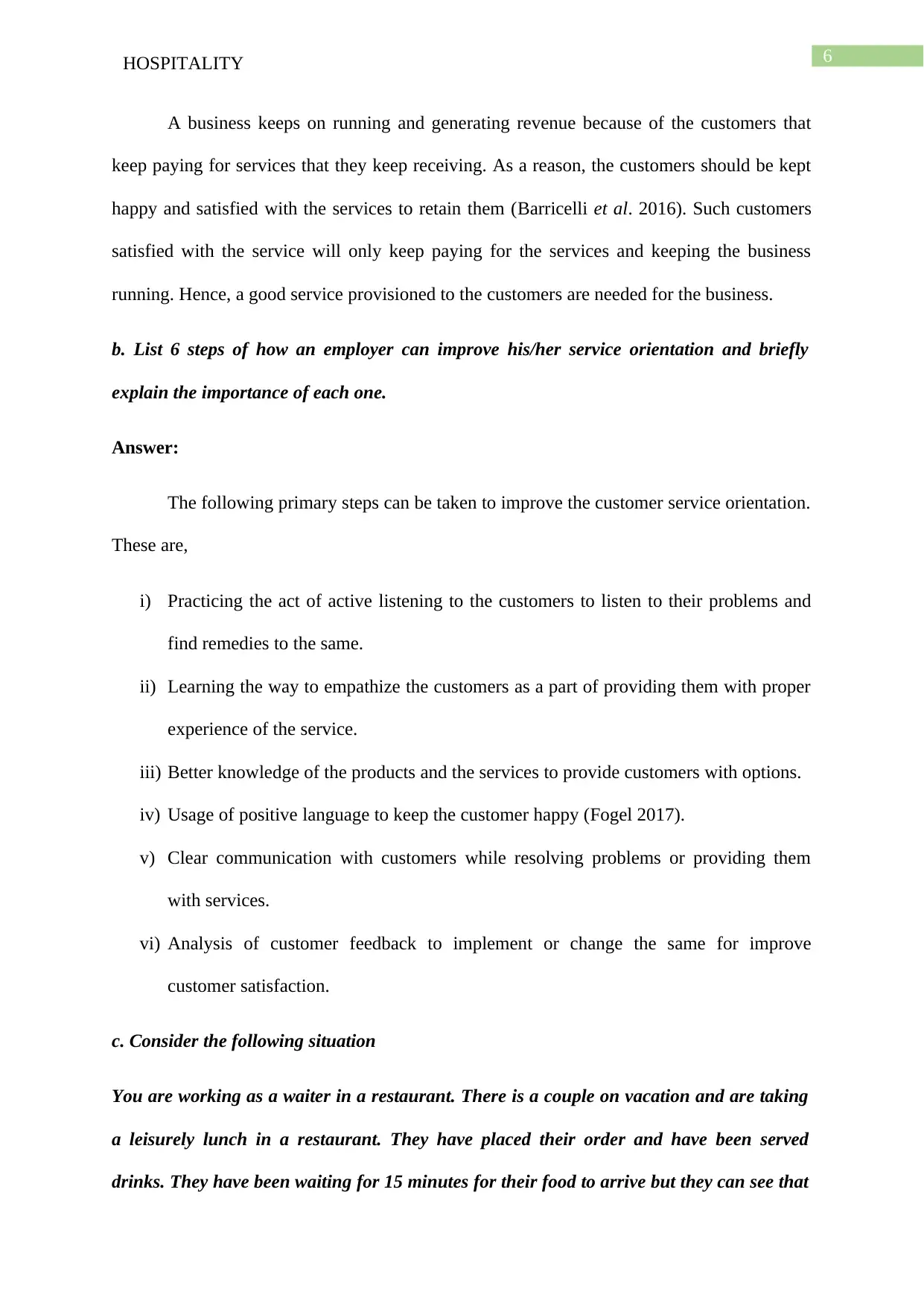
6HOSPITALITY
A business keeps on running and generating revenue because of the customers that
keep paying for services that they keep receiving. As a reason, the customers should be kept
happy and satisfied with the services to retain them (Barricelli et al. 2016). Such customers
satisfied with the service will only keep paying for the services and keeping the business
running. Hence, a good service provisioned to the customers are needed for the business.
b. List 6 steps of how an employer can improve his/her service orientation and briefly
explain the importance of each one.
Answer:
The following primary steps can be taken to improve the customer service orientation.
These are,
i) Practicing the act of active listening to the customers to listen to their problems and
find remedies to the same.
ii) Learning the way to empathize the customers as a part of providing them with proper
experience of the service.
iii) Better knowledge of the products and the services to provide customers with options.
iv) Usage of positive language to keep the customer happy (Fogel 2017).
v) Clear communication with customers while resolving problems or providing them
with services.
vi) Analysis of customer feedback to implement or change the same for improve
customer satisfaction.
c. Consider the following situation
You are working as a waiter in a restaurant. There is a couple on vacation and are taking
a leisurely lunch in a restaurant. They have placed their order and have been served
drinks. They have been waiting for 15 minutes for their food to arrive but they can see that
A business keeps on running and generating revenue because of the customers that
keep paying for services that they keep receiving. As a reason, the customers should be kept
happy and satisfied with the services to retain them (Barricelli et al. 2016). Such customers
satisfied with the service will only keep paying for the services and keeping the business
running. Hence, a good service provisioned to the customers are needed for the business.
b. List 6 steps of how an employer can improve his/her service orientation and briefly
explain the importance of each one.
Answer:
The following primary steps can be taken to improve the customer service orientation.
These are,
i) Practicing the act of active listening to the customers to listen to their problems and
find remedies to the same.
ii) Learning the way to empathize the customers as a part of providing them with proper
experience of the service.
iii) Better knowledge of the products and the services to provide customers with options.
iv) Usage of positive language to keep the customer happy (Fogel 2017).
v) Clear communication with customers while resolving problems or providing them
with services.
vi) Analysis of customer feedback to implement or change the same for improve
customer satisfaction.
c. Consider the following situation
You are working as a waiter in a restaurant. There is a couple on vacation and are taking
a leisurely lunch in a restaurant. They have placed their order and have been served
drinks. They have been waiting for 15 minutes for their food to arrive but they can see that
Paraphrase This Document
Need a fresh take? Get an instant paraphrase of this document with our AI Paraphraser
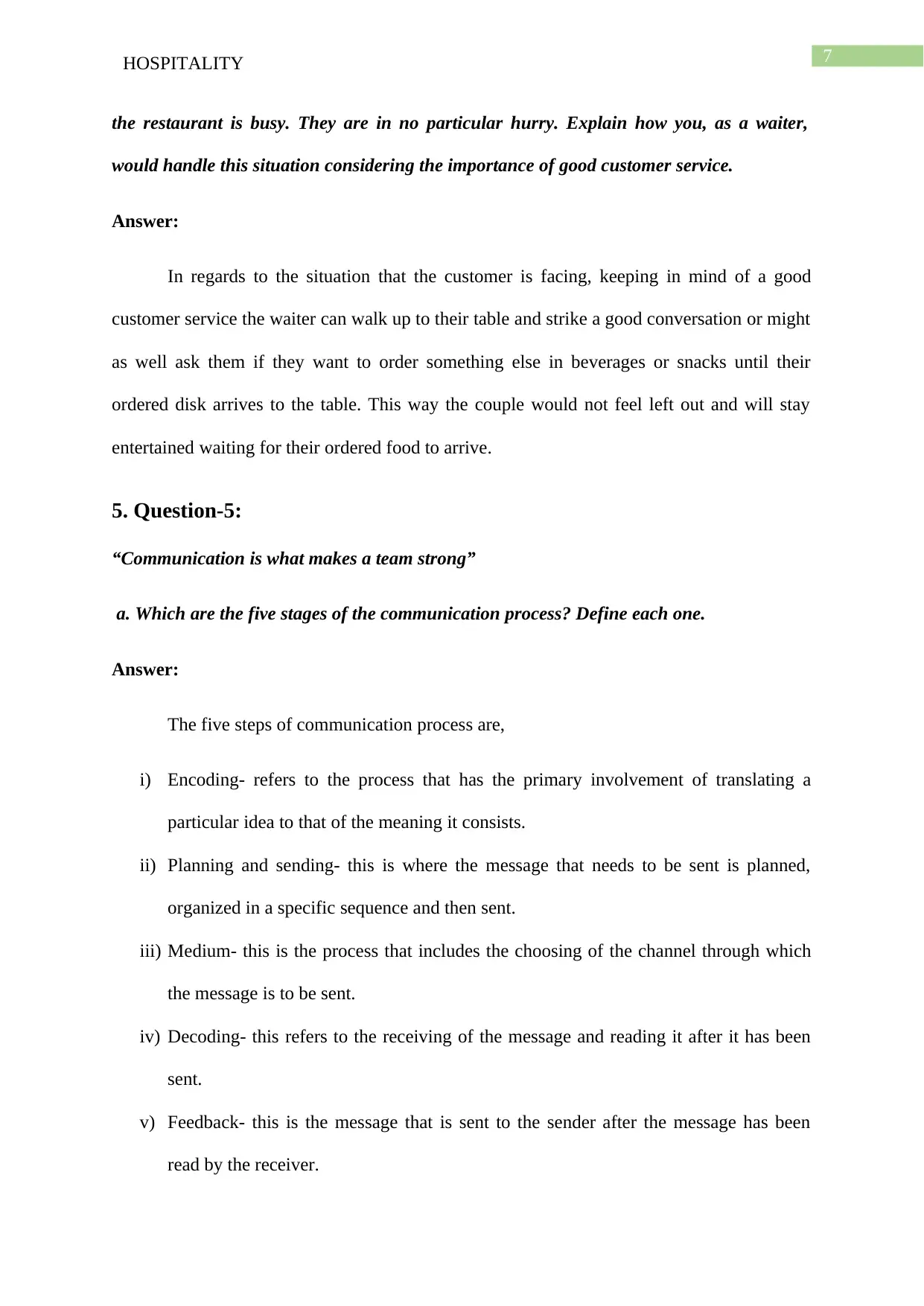
7HOSPITALITY
the restaurant is busy. They are in no particular hurry. Explain how you, as a waiter,
would handle this situation considering the importance of good customer service.
Answer:
In regards to the situation that the customer is facing, keeping in mind of a good
customer service the waiter can walk up to their table and strike a good conversation or might
as well ask them if they want to order something else in beverages or snacks until their
ordered disk arrives to the table. This way the couple would not feel left out and will stay
entertained waiting for their ordered food to arrive.
5. Question-5:
“Communication is what makes a team strong”
a. Which are the five stages of the communication process? Define each one.
Answer:
The five steps of communication process are,
i) Encoding- refers to the process that has the primary involvement of translating a
particular idea to that of the meaning it consists.
ii) Planning and sending- this is where the message that needs to be sent is planned,
organized in a specific sequence and then sent.
iii) Medium- this is the process that includes the choosing of the channel through which
the message is to be sent.
iv) Decoding- this refers to the receiving of the message and reading it after it has been
sent.
v) Feedback- this is the message that is sent to the sender after the message has been
read by the receiver.
the restaurant is busy. They are in no particular hurry. Explain how you, as a waiter,
would handle this situation considering the importance of good customer service.
Answer:
In regards to the situation that the customer is facing, keeping in mind of a good
customer service the waiter can walk up to their table and strike a good conversation or might
as well ask them if they want to order something else in beverages or snacks until their
ordered disk arrives to the table. This way the couple would not feel left out and will stay
entertained waiting for their ordered food to arrive.
5. Question-5:
“Communication is what makes a team strong”
a. Which are the five stages of the communication process? Define each one.
Answer:
The five steps of communication process are,
i) Encoding- refers to the process that has the primary involvement of translating a
particular idea to that of the meaning it consists.
ii) Planning and sending- this is where the message that needs to be sent is planned,
organized in a specific sequence and then sent.
iii) Medium- this is the process that includes the choosing of the channel through which
the message is to be sent.
iv) Decoding- this refers to the receiving of the message and reading it after it has been
sent.
v) Feedback- this is the message that is sent to the sender after the message has been
read by the receiver.
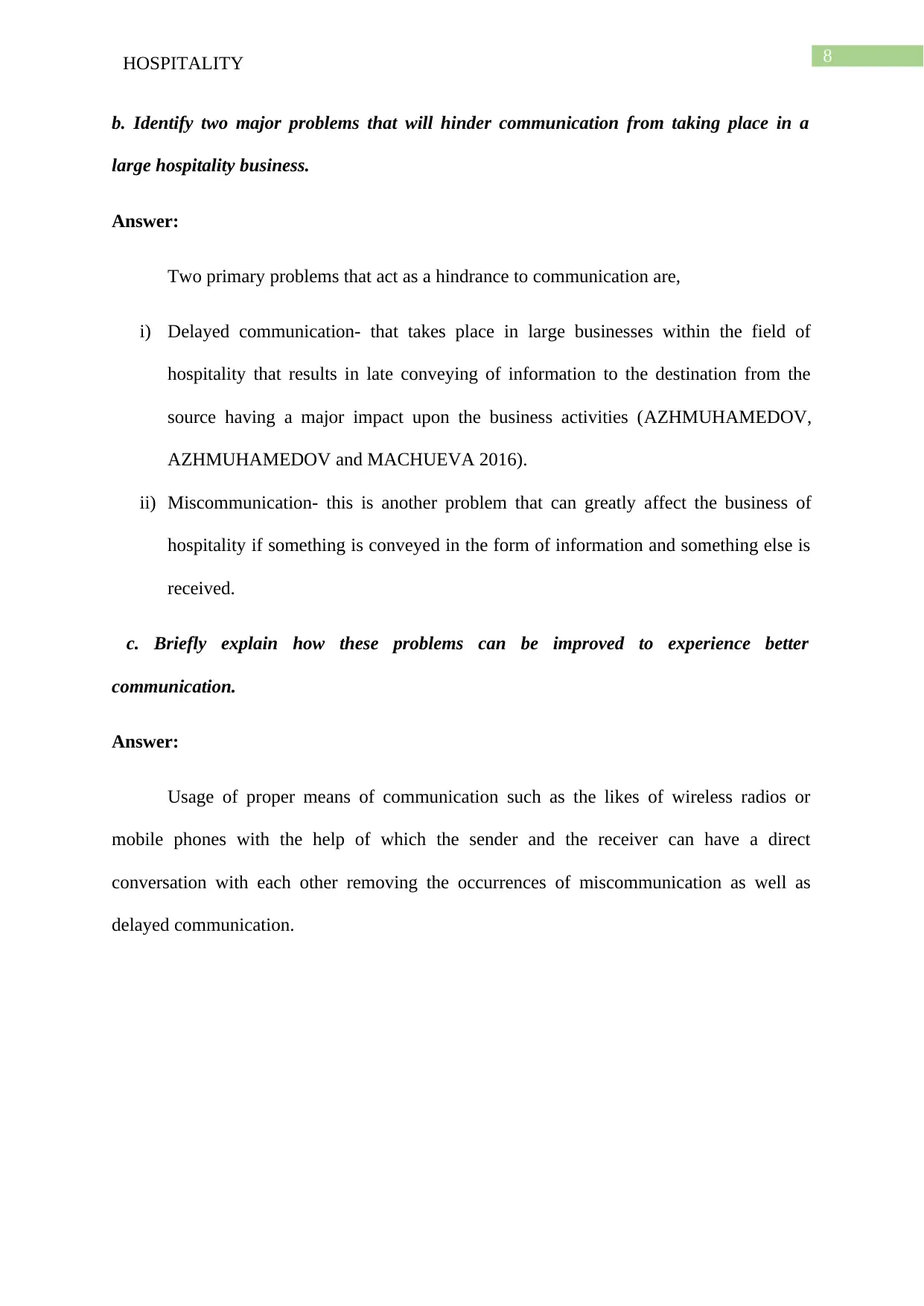
8HOSPITALITY
b. Identify two major problems that will hinder communication from taking place in a
large hospitality business.
Answer:
Two primary problems that act as a hindrance to communication are,
i) Delayed communication- that takes place in large businesses within the field of
hospitality that results in late conveying of information to the destination from the
source having a major impact upon the business activities (AZHMUHAMEDOV,
AZHMUHAMEDOV and MACHUEVA 2016).
ii) Miscommunication- this is another problem that can greatly affect the business of
hospitality if something is conveyed in the form of information and something else is
received.
c. Briefly explain how these problems can be improved to experience better
communication.
Answer:
Usage of proper means of communication such as the likes of wireless radios or
mobile phones with the help of which the sender and the receiver can have a direct
conversation with each other removing the occurrences of miscommunication as well as
delayed communication.
b. Identify two major problems that will hinder communication from taking place in a
large hospitality business.
Answer:
Two primary problems that act as a hindrance to communication are,
i) Delayed communication- that takes place in large businesses within the field of
hospitality that results in late conveying of information to the destination from the
source having a major impact upon the business activities (AZHMUHAMEDOV,
AZHMUHAMEDOV and MACHUEVA 2016).
ii) Miscommunication- this is another problem that can greatly affect the business of
hospitality if something is conveyed in the form of information and something else is
received.
c. Briefly explain how these problems can be improved to experience better
communication.
Answer:
Usage of proper means of communication such as the likes of wireless radios or
mobile phones with the help of which the sender and the receiver can have a direct
conversation with each other removing the occurrences of miscommunication as well as
delayed communication.
⊘ This is a preview!⊘
Do you want full access?
Subscribe today to unlock all pages.

Trusted by 1+ million students worldwide
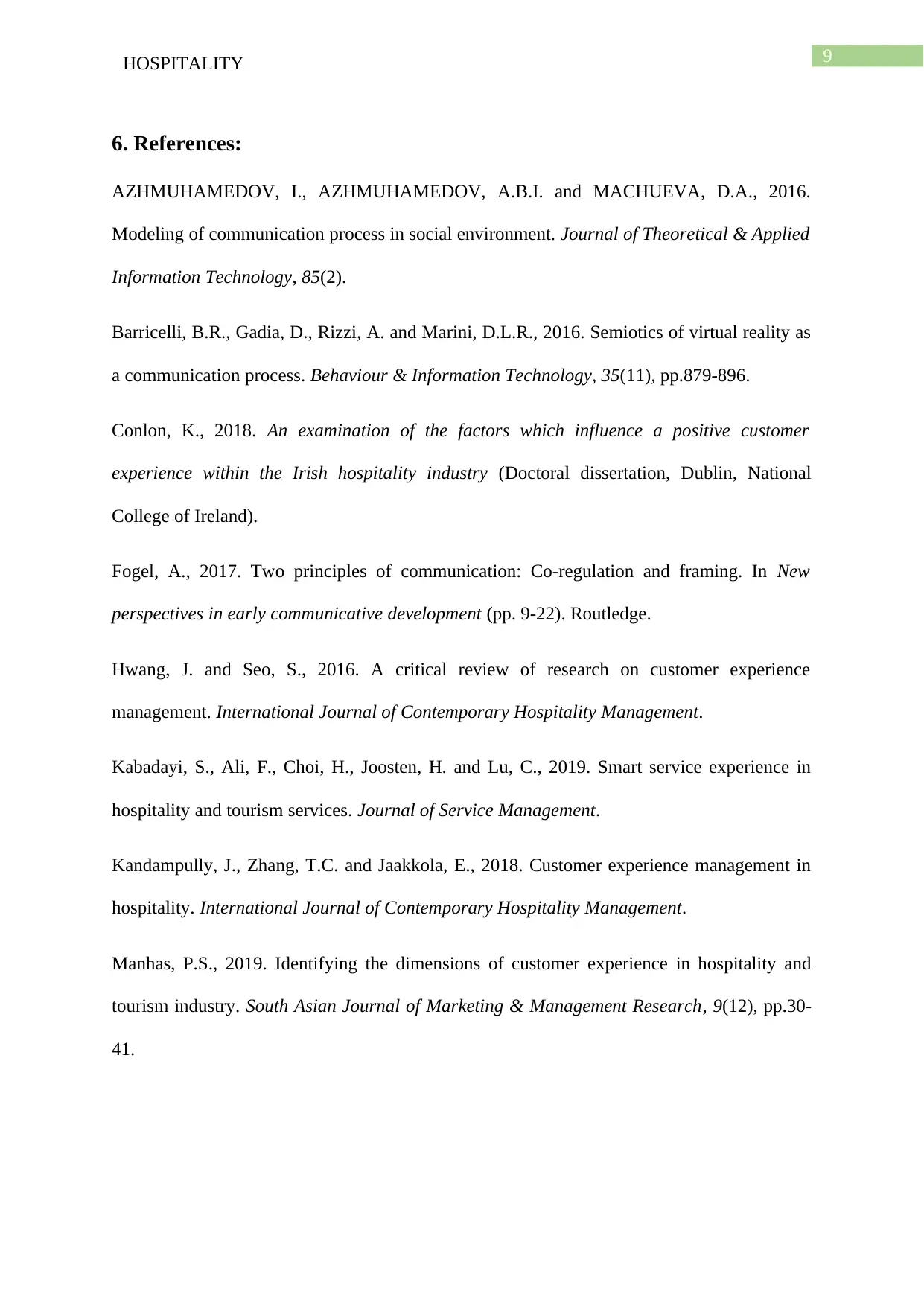
9HOSPITALITY
6. References:
AZHMUHAMEDOV, I., AZHMUHAMEDOV, A.B.I. and MACHUEVA, D.A., 2016.
Modeling of communication process in social environment. Journal of Theoretical & Applied
Information Technology, 85(2).
Barricelli, B.R., Gadia, D., Rizzi, A. and Marini, D.L.R., 2016. Semiotics of virtual reality as
a communication process. Behaviour & Information Technology, 35(11), pp.879-896.
Conlon, K., 2018. An examination of the factors which influence a positive customer
experience within the Irish hospitality industry (Doctoral dissertation, Dublin, National
College of Ireland).
Fogel, A., 2017. Two principles of communication: Co-regulation and framing. In New
perspectives in early communicative development (pp. 9-22). Routledge.
Hwang, J. and Seo, S., 2016. A critical review of research on customer experience
management. International Journal of Contemporary Hospitality Management.
Kabadayi, S., Ali, F., Choi, H., Joosten, H. and Lu, C., 2019. Smart service experience in
hospitality and tourism services. Journal of Service Management.
Kandampully, J., Zhang, T.C. and Jaakkola, E., 2018. Customer experience management in
hospitality. International Journal of Contemporary Hospitality Management.
Manhas, P.S., 2019. Identifying the dimensions of customer experience in hospitality and
tourism industry. South Asian Journal of Marketing & Management Research, 9(12), pp.30-
41.
6. References:
AZHMUHAMEDOV, I., AZHMUHAMEDOV, A.B.I. and MACHUEVA, D.A., 2016.
Modeling of communication process in social environment. Journal of Theoretical & Applied
Information Technology, 85(2).
Barricelli, B.R., Gadia, D., Rizzi, A. and Marini, D.L.R., 2016. Semiotics of virtual reality as
a communication process. Behaviour & Information Technology, 35(11), pp.879-896.
Conlon, K., 2018. An examination of the factors which influence a positive customer
experience within the Irish hospitality industry (Doctoral dissertation, Dublin, National
College of Ireland).
Fogel, A., 2017. Two principles of communication: Co-regulation and framing. In New
perspectives in early communicative development (pp. 9-22). Routledge.
Hwang, J. and Seo, S., 2016. A critical review of research on customer experience
management. International Journal of Contemporary Hospitality Management.
Kabadayi, S., Ali, F., Choi, H., Joosten, H. and Lu, C., 2019. Smart service experience in
hospitality and tourism services. Journal of Service Management.
Kandampully, J., Zhang, T.C. and Jaakkola, E., 2018. Customer experience management in
hospitality. International Journal of Contemporary Hospitality Management.
Manhas, P.S., 2019. Identifying the dimensions of customer experience in hospitality and
tourism industry. South Asian Journal of Marketing & Management Research, 9(12), pp.30-
41.
1 out of 10
Related Documents
Your All-in-One AI-Powered Toolkit for Academic Success.
+13062052269
info@desklib.com
Available 24*7 on WhatsApp / Email
![[object Object]](/_next/static/media/star-bottom.7253800d.svg)
Unlock your academic potential
Copyright © 2020–2025 A2Z Services. All Rights Reserved. Developed and managed by ZUCOL.




